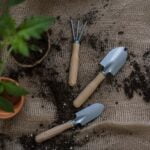A well-designed small garden can bring joy and beauty to any outdoor space, no matter how limited. Whether you have a tiny backyard or a balcony, the layout and design of your garden can greatly impact its functionality and aesthetic appeal. In this article, we will explore the importance and benefits of a well-designed small garden, offering tips and ideas to help you create a stunning and functional outdoor oasis.
Gardening in a limited space comes with its own unique challenges, but it also offers countless opportunities for creativity and innovation. One of the key benefits of designing a small garden is that it forces you to be intentional with every element you choose. From plants and furniture to pathways and lighting, every aspect of your garden’s layout should be carefully considered to maximize its potential.
A well-designed small garden not only enhances the visual appeal of your outdoor space but also provides an extension of your living area. It can serve as an inviting retreat where you can relax after a long day or entertain guests during warm summer evenings. Additionally, small gardens are often easier to maintain compared to larger ones, making them ideal for those with busy schedules or limited gardening experience.
In the following sections, we will guide you through the process of creating an enchanting small garden that suits your unique style and needs. We will discuss various topics such as assessing your space, choosing appropriate themes, selecting the right plants, maximizing vertical space, creating pathways, selecting furniture and decor pieces, exploring different lighting techniques, and providing maintenance tips. So grab your gardening gloves and join us on this exciting journey towards creating a perfect small garden oasis.
Assessing Your Space
When designing a small garden, it is crucial to start by assessing the available space. By measuring and evaluating the area, you can make informed decisions about which elements and features will work best in your garden design. Here are some tips to help you assess your space effectively.
Firstly, take accurate measurements of your small garden using a tape measure or measuring tool. Measure the length and width of the entire area, as well as any specific sections or boundaries within the garden. This will give you a clear understanding of the size and shape of your space, allowing you to plan accordingly.
Next, consider the orientation and exposure of your small garden. Take note of where the sun shines throughout the day and identify any shady areas that may have different light conditions. This information will be valuable when selecting suitable plants for your garden, as certain plants thrive in full sun while others prefer partial shade.
In addition to size and sunlight, evaluate other environmental factors that can affect your small garden design. Assess the soil condition and drainage in your garden to determine if any improvements are needed before planting. Consider nearby structures or trees that could create shade or block sunlight. These evaluations will help you better understand how to optimize your space for successful gardening.
By taking the time to assess your small garden space thoroughly, you can lay a solid foundation for an effective design plan. Understanding its dimensions, lighting conditions, and environmental factors will ensure that you make informed decisions when selecting plants, choosing furniture, creating pathways, and implementing other design elements in order to maximize its potential. With careful evaluation comes a well-designed small garden that perfectly suits both your needs and preferences.
Choosing a Theme
When it comes to designing a small garden, choosing the right theme can make all the difference. A well-chosen garden theme can help create a cohesive and visually appealing space that makes the most of your limited area. There are several garden themes that work particularly well in small spaces, including cottage, modern, and Japanese styles.
The cottage garden theme is a popular choice for small gardens because it exudes charm and coziness. This style typically incorporates an abundance of colorful flowers, delicate plants, and whimsical accessories. To create a cottage-inspired small garden, opt for plants such as roses, lavender, and daisies. Incorporate vintage-inspired furniture and accessories like birdhouses or rustic benches to enhance the overall aesthetic.
For those who prefer a more contemporary look, the modern garden theme is an excellent option for small spaces. This style emphasizes clean lines and minimalist design elements. Choose plants with architectural shapes and bold foliage for a striking effect. Use materials like concrete or metal for pathways and seating areas to create a sleek and polished look. Incorporate modern features such as outdoor sculptures or geometric planters to add interest to your small garden.
If you’re looking to create a peaceful and tranquil atmosphere in your small garden, consider the Japanese garden theme. This style is characterized by elements such as water features, bamboo accents, and carefully placed rocks. Choose plants like Japanese maples or bamboo that thrive in shaded areas. Add elements such as lanterns or stone pagodas to complete the Japanese aesthetic.
No matter which theme you choose for your small garden design, remember that personalization is key. Don’t be afraid to mix different elements from various themes to create a unique space that reflects your personality and preferences. With careful planning and attention to detail, you can transform even the smallest of gardens into an oasis of beauty and relaxation.
Selecting the Right Plants
When designing a small garden, selecting the right plants is crucial for creating a beautiful and functional space. In this section, we will discuss some of the best plants for small gardens that can provide colorful blooms, require low maintenance, and offer vertical growth.
One option for adding vibrant color to your small garden is by choosing plants that produce colorful blooms. Flowers like roses, tulips, and daisies can add a pop of color and create an eye-catching focal point in your garden. Additionally, consider incorporating flowering vines such as clematis or morning glory to add height and vertical interest.
If you’re looking for low-maintenance plants that still bring beauty to your small garden, there are several options to consider. Succulents and cacti are excellent choices as they require minimal watering and thrive in sunny spots. Herbs like lavender or rosemary not only require little upkeep but also emit a fragrant aroma that adds to the overall ambience of your garden.
For gardens with limited horizontal space, selecting plants with vertical growth habits can help make the most of the available area. Climbing plants like ivy or jasmine can be trained to grow up trellises or walls, adding visual interest while saving valuable ground space. Additionally, tall grasses or slender trees such as bamboo provide privacy while maintaining a sense of openness in a small garden.
In summary, when it comes to selecting the right plants for your small garden design, consider those that bring colorful blooms, require low maintenance, or offer vertical growth. By carefully choosing these plants based on your preferences and the conditions of your garden’s environment, you can create a stunning landscape that maximizes both space and aesthetics.
Maximizing Vertical Space
Utilizing Trellises
One of the most effective ways to maximize vertical space in a small garden is by using trellises. Trellises not only create a stunning visual focal point but also provide support for climbing plants, allowing them to grow upwards instead of sprawling across the ground. There are various types of trellises available, including freestanding and wall-mounted options, making them suitable for any garden layout.
When choosing a trellis, consider the size and weight of the plants you intend to grow. Opt for a sturdy material such as metal or wood that can withstand the weight and provide ample support. Place the trellis strategically against a wall or along a boundary to create an illusion of depth and make your small garden appear larger than it actually is.
Hanging Plants
Another fantastic way to utilize vertical space in a small garden is by incorporating hanging plants. Hanging baskets and planters can be suspended from walls, pergolas, or even tree branches to add layers of greenery at eye level. This not only creates visual interest but also frees up valuable floor space, allowing you to introduce more plants without overcrowding.
Choose trailing or cascading plants that will gracefully spill over the sides of their containers. Consider mixing different types of foliage with complementary colors to create an enchanting display. Additionally, be mindful of the weight when selecting hanging planters to ensure they can be securely supported by their mounting brackets or hooks.
Vertical Gardens
If you’re looking for even more possibilities in maximizing vertical space, consider creating a vertical garden in your small outdoor area. Vertical gardens allow you to grow plants on vertically arranged structures such as living walls or modular planting systems. These innovative designs not only add greenery and texture but also act as natural insulators, helping regulate temperature and sound.
When designing a vertical garden, keep in mind the specific needs of the plants you choose, such as light and watering requirements. It’s essential to ensure proper drainage and irrigation systems to prevent water damage to your structures. Consider incorporating a variety of plants with different colors, textures, and heights for a visually dynamic and captivating vertical garden.
By utilizing trellises, hanging plants, and vertical gardens, you can transform a small garden into a lush and thriving oasis that defies its limited space. These creative ideas enable you to create a verdant paradise while simultaneously maximizing the available area without overwhelming it. Embrace your green thumb and experiment with different combinations to find the perfect balance of beauty and functionality in your small garden design.
Creating Pathways
In a small garden, the design of pathways plays a crucial role in maximizing space, enhancing accessibility, and creating a visually appealing layout. Well-planned pathways not only create functional trails for navigating through the garden but also add structure and character to the overall design. Here are some tips and design suggestions to help you create pathways that are both functional and visually appealing in your small garden.
Determine the Purpose
Before designing your pathways, consider the purpose they will serve in your small garden. Are they meant primarily for transitioning between different areas of the garden or do you want them to be focal points themselves? By determining their purpose, you can prioritize factors such as width, material choices, and placement.
Choose Suitable Materials
When it comes to materials for your pathway, consider options that blend well with the overall aesthetic of your small garden. For a natural look, gravel or stepping stones can create an inviting path. If you prefer a more formal appeal, brick pavers or concrete tiles may be more suitable choices. The choice of materials should also take into account any potential hazards or limitations within your outdoor space.
Create Visual Interest
Incorporating elements of visual interest along your pathways can make them more engaging and visually appealing. Planting low-growing colorful flowers or ornamental grasses along the edges can add a touch of beauty while maintaining a compact design. Additionally, incorporating focal points like sculptures or decorative planters along the pathway can draw attention and create unique visual experiences.
Use Curves Strategically
Incorporating curved paths instead of straight ones can help create an illusion of more space in a small garden by breaking up the visual monotony. These curves can gently guide visitors through the garden, revealing different sections and creating a sense of discovery. However, it is essential to strike a balance between gentle curves and functional navigation.
By considering these design suggestions, you can ensure that your pathways not only serve their functional purpose but also enhance the overall aesthetics of your small garden. Keep in mind that personal creativity and customization are key to creating a unique and inviting outdoor space that reflects your individual style and preferences.
Furniture and Decor
When designing a small garden, choosing the right furniture and decorative elements is crucial in creating a harmonious and inviting space. The appropriate selection of items can greatly enhance the ambiance and maximize the functionality of your garden. Here are some tips on how to select appropriate furniture and decorative elements for a small garden design.
1. Space-saving options: In small gardens, it’s important to choose furniture that doesn’t take up too much space but still provides comfort. Look for compact and multi-functional pieces such as folding chairs and tables, stackable stools, or benches with built-in storage. These options allow you to easily adjust your seating arrangement based on different needs while saving valuable space.
2. Proper placement: Consider the layout of your garden when placing furniture and decorative elements. Optimize your available space by locating larger items against walls or fences, leaving the center area open for movement. Arrange seating areas in cozy corners or focal points where you can enjoy views or create conversation spots. By properly placing furniture, you can maximize functionality while maintaining an open and spacious feel.
3. Material choice: When selecting furniture for a small garden, consider materials that are durable and suitable for outdoor use. Teak, wrought iron, or aluminum are popular choices as they are weather-resistant and require minimal maintenance. Additionally, choose fabrics for cushions or upholstery that are UV-resistant and easy to clean so that they can withstand outdoor conditions.
In terms of decorative elements, choose carefully curated pieces that add personality without overwhelming the space. Hanging planters or vertical gardens can be used to add greenery without taking up valuable ground area. Adding pops of color through vibrant cushions, throw pillows, or outdoor rugs can help create visual interest in a small garden design while reflecting your personal style.
Remember, the key is to create a cohesive and balanced look by selecting furniture and decorative elements that complement each other and the overall theme of your garden. With careful consideration, you can transform your small garden into a charming and inviting retreat.
Lighting Options
To truly make your small garden shine, it is important to consider the lighting options available. Proper lighting can transform a small garden into an enchanting space even after the sun goes down. There are various techniques you can use to create a magical ambiance in your outdoor oasis.
One popular lighting option for small gardens is string lights. These versatile lights come in a variety of styles and can be easily hung along fences, trellises, or overhead to create a warm and inviting glow. Whether you opt for classic white bulbs or colorful lanterns, string lights add a touch of whimsy and charm to any garden.
Another eco-friendly option is solar-powered fixtures. These lights absorb energy from the sun during the day and automatically illuminate your garden at night. Solar-powered lights are easy to install and require no wiring, making them perfect for small spaces. You can place them along pathways or strategically position them among plants for a soft and gentle glow.
In addition to string lights and solar-powered fixtures, accent lights can also enhance the beauty of your small garden at night. By strategically placing spotlights or uplights, you can highlight specific features such as trees, sculptures, or water elements, creating dramatic shadows and depth. Accent lights not only provide practical illumination but also add an extra layer of visual interest to your outdoor space.
By carefully selecting the right lighting options for your small garden, you can create an enchanting atmosphere that allows you to enjoy your outdoor sanctuary long after sunset. Whether you choose string lights for a romantic atmosphere or accent lights for dramatic effects, proper lighting will help showcase the beauty of your plants and decor while adding warmth and charm to your small garden.
Maintenance and Care
Maintaining and caring for a small garden is crucial to keeping it healthy and thriving. Proper maintenance ensures that your plants receive the necessary attention and care they need to grow and flourish. In this section, we will provide essential tips on tending to a small garden, including watering schedules, pruning techniques, and pest control strategies.
Watering is one of the most important aspects of garden maintenance. In a small garden, it is vital to water your plants regularly, especially during dry spells or hot summer months. The frequency of watering will depend on various factors such as plant type, weather conditions, and soil moisture levels.
To determine when to water, check the soil’s moisture level by inserting your finger about an inch into the ground. If it feels dry, it’s time to water. It’s advisable to water deeply at the base of each plant rather than lightly sprinkling the entire area.
Another essential aspect of maintaining a small garden is pruning. Regular pruning helps promote healthy growth and keeps your plants in shape. Trim any dead or damaged leaves or branches to maintain their overall health and appearance. Additionally, pruning can help control the size of plants in a limited space, preventing overcrowding and allowing sunlight to reach all areas of the garden.
Pest control is crucial in ensuring the long-term health of your small garden. Regularly inspect your plants for signs of infestation such as holes in leaves or chewed stems.
If you notice any pests, identify them correctly before applying appropriate solutions like organic sprays or introducing beneficial insects that prey on garden pests. Keep in mind that prevention is key – practicing good gardening habits like proper sanitation and regular maintenance can help reduce the risk of pests infesting your small garden.
By following these essential tips on maintaining and caring for your small garden, you can ensure its overall success and beauty throughout all seasons. Remember that each plant may have specific needs, so it’s important to research their individual care requirements. With proper watering, pruning, and pest control, your small garden will continue to thrive and be a source of joy and relaxation for years to come.
Conclusion
In conclusion, designing a well-appointed small garden can bring numerous benefits and enhance the overall ambiance of your outdoor space. Throughout this article, we have explored various aspects of small garden design, from assessing your available space to choosing a theme, selecting the right plants, maximizing vertical space, creating pathways, selecting furniture and decor, considering lighting options, and understanding maintenance and care.
One key takeaway from this discussion is the importance of personal creativity and customization in small garden design. While we have provided tips and suggestions throughout the article, it is essential to remember that your small garden should reflect your own style and preferences. By infusing your personality into the design, you can create a unique outdoor sanctuary that brings you joy and satisfaction.
Furthermore, embracing creativity allows you to optimize limited space effectively. Whether it’s through vertical gardening techniques or strategic placement of furniture and decor, there are countless opportunities to maximize every inch of a small garden. Experiment with different plant choices or incorporate unexpected elements to add intrigue and charm.
Ultimately, small garden design should be an enjoyable process that enables you to create a beautiful and functional space. Remember to take your time during the planning phase, assess your specific needs and desires for the garden, and continuously experiment with new ideas. With these principles in mind, you can transform a tiny patch of land into a captivating oasis that brings beauty to your home while showcasing your individuality.
Frequently Asked Questions
How Do You Structure a Small Garden?
When structuring a small garden, it is essential to consider its purpose and your personal aesthetic preferences. Start by defining different areas within the garden, such as seating or dining spaces, flower beds, vegetable patches, or even a small water feature. Utilize vertical space by incorporating trellises or hanging baskets to maximize planting options. Opt for compact plants that don’t overpower the space and choose ones that complement each other in color and height.
Creating pathways can help navigate through the garden while maintaining its structure. Remember to consider lighting options that will enhance specific elements of the garden during nighttime. Overall, the key is to strike a balance between functionality and visual appeal in a limited area.
How Do I Design a Small Garden Idea?
Designing a small garden idea involves careful planning to optimize space utilization while creating an aesthetically pleasing environment. First, determine the theme or style you wish to incorporate into your garden, be it modern, traditional, or eclectic. Choose a color palette that complements your desired style and select plants accordingly – flowers for vibrant bursts of color or foliage plants for a more serene atmosphere.
Consider incorporating containers or raised beds to grow plants vertically and save space. Add focal points such as sculptures or decorative objects to highlight specific features within the garden. Lastly, play with textures by combining different materials like gravel paths alongside lush greenery or using wooden accents for warmth.
How Do You Design a Garden Layout?
Designing a garden layout requires careful consideration of numerous factors including climate, soil conditions, available sunlight, drainage systems, and use of outdoor spaces. To begin, analyze the land’s topography and assess any slopes or uneven terrain that may need modifications like terracing or retaining walls for stability purposes and efficient water flow management. Identify areas where direct sunlight occurs throughout the day as well as sections prone to shade based on nearby structures or trees; this information will help determine what type of plants thrive best in each location.
Prioritize functional spaces like seating areas or play zones while ensuring they blend seamlessly into the overall design. Sufficient pathways and delineated borders will help guide traffic flow throughout the garden. Ultimately, a well-designed garden layout should harmonize with both the natural environment and your specific needs.

Welcome to my gardening blog! I am passionate about plants and enjoy sharing my knowledge and experiences with others. In this blog, I will write about everything related to gardening, from tips on how to get started to updates on my own garden projects.





